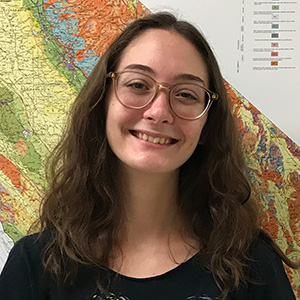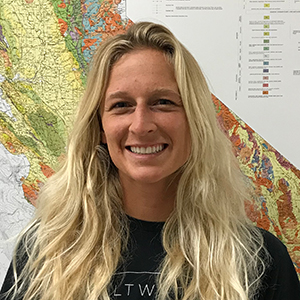Summer 2024

Tyler Hayduk
M.S. candidate
Advisor: Dr. Samantha Bova
The role of the Congo River outflow and oceanic upwelling on phytoplankton in the Angola Basin across three Pleistocene glacial-interglacial transitions
Friday, August, 5, 2024 at 9 am
watch Tyler’s talk
Abstract:
Nutrients supplied to the Angola Basin via a combination of oceanic upwelling (high nitrate) and Congo River inputs (high silica) support high rates of primary productivity and a diverse community of phytoplankton. Changes in the supply of nutrients from either of these two pathways may alter regional phytoplankton assemblages, given different nutrient requirements which may impact their abundance and ability to compete against one another. Here we use the abundance of two organic biomarkers, alkenones and brassicasterol, to reconstruct variations in coccolithophore and diatom populations, respectively, at Ocean Drilling Program Site 1077, recovered on the northern margin of the Congo Fan within the Angola Basin during three Pleistocene interglacials (Holocene, Last Interglacial, and Marine Isotope Stage (MIS) 9) and their preceding glacial terminations. Diatoms, unlike coccolithophores, construct silica tests making them dependent on the concentration of silicic acid. Our results demonstrate that total paleoproductivity within the basin is primarily driven by oceanic upwelling, which in turn varies with the strength of the trade winds due to changes in orbital precession. Total paleoproductivity is especially strong during glacial terminations, possibly indicating an increase in both the upwelling rate and the nutrient content of the upwelled water. Conversely, assemblage-specific fitness is primarily governed by Congo River inputs. This is despite previous microfossil records showing invariant levels of siliceous productivity during MIS 9 and 10, validating the robustness of our proxies. Hence, our analysis underlines the importance of investigating multiple biomarkers that reveal how changes in assemblage-specific populations reveal changes in climatic conditions.

Santiago Diacono Losada
M.S. candidate
Advisor: Dr. Matthew Weingarten
Forward-Looking Red-Light Thresholds to Manage Hydraulic Fracturing Induced Seismicity Risk: A Case Study of Middle Magdalena Valley, Colombia
Friday, August 2, 2024 at 9:45 am
watch Santiago’s talk
Abstract
Earthquakes induced by hydraulic fracturing (HF) stimulations are considered one of the main environmental risks of unconventional hydrocarbon extraction. Concern over induced seismicity was one factor in the Colombian Government’s termination of two licenses for proposed HF operations in the Middle Magdalena Valley (MMV) of Colombia – a region known for its organic-rich shales and historical conventional oil production. Management of HF induced seismicity has typically been done using a Traffic Light Protocol (TLP), where exceeding a ‘red-light’ threshold produces complete shut-in of well operations. Here, we utilize two risk-based metrics, the probability of nuisance and the probability of damage, to calculate red-light thresholds across the MMV. Adapting the methodology of Schultz et al. [2021], we show that the severity of nuisance and damage risks spatially vary by orders-of-magnitude across the MMV and depend strongly on exposure. Our estimates of red-light magnitude are generally within the range of ML2.5 – ML3.5 with our models showing that the probability of damage dominates seismic risk near populated areas while rural areas are often controlled by the probability of nuisance. We found the safest region for unconventional development is further north than the existing proposed HF pilot projects in the MMV, as this is where population densities are very low. Our model is inherently forward-looking, as HF operations in Colombia have not yet occurred, but we emphasize the model’s recommendations in the proactive management of HF induced earthquake risks. In addition, the model is highly adaptable to stakeholder risk-tolerance, as any threshold of nuisance and damage probability could be considered.

Logan Platt
M.S. candidate
Advisor: Dr. Matthew Weingarten
Modeling future groundwater depletion to evaluate sustainability goals set by SGMA in the Central Valley, California, USA (2020-2070)
Friday, August 2, 2024 at 10:30 am
watch Logan’s talk
Abstract
In 2014, California enacted the Sustainable Groundwater Management Act (SGMA) to ensure the long-term viability of the state’s groundwater resources. SGMA mandated the creation of Groundwater Sustainability Plans (GSPs) by local groundwater sustainability agencies, which began implementation in 2020. These GSPs are designed to provide transparency regarding how local managers plan to achieve sustainable groundwater management. To assess the sustainability goals outlined in these plans, we compiled data from GSPs, focusing on the critically overdrafted basins within California’s Central Valley. We developed a database of sustainability indicator wells from these plans, along with their associated groundwater elevation targets for 2040. This database includes 936 wells from both the upper and lower portions of the Central Valley aquifer, with groundwater elevation targets ranging from approximately 60 meters above to 80 meters below 2020 levels. Our analysis identified significant variability in elevation targets both within and between groundwater subbasins. Using a regional groundwater model for the Central Valley aquifer system, we evaluated these targets against future groundwater depletion scenarios. Simulations projecting increased demand suggest that 60% to 70% of indicator wells may fail to meet the 2040 groundwater elevation targets. Even with a 50% reduction in demand from 2020 levels, nearly 40% of wells in both the shallow and deep portions of the aquifer may still fall short of the 2040 goals. Furthermore, baseline simulations indicate that by 2070, large-scale, transboundary groundwater depletion between subbasins could result in 70% of wells failing to achieve their groundwater elevation objectives.
Spring 2024

Liam Schramm B.S.
M.S. candidate
Advisor: Dr. Rafael Almeida
Deciphering the Recent Uplift of the Western Cordillera of the Ecuadorian Andes using Fluvial Geomorphology
Thursday, May 2, 2024 at 3:45 pm
watch Liam’s talk

Bradley Keith B.S.
M.S. candidate
Advisor: Dr. Samantha Bova
Half-Precession Pacing of the Southern Westerly Winds and the Patagonia Ice Sheet over the Last 900,000 Years
Friday, April 26, 2024 at 9:45 am
watch Brad’s talk
Abstract
Reconstructions of the Patagonian Ice Sheet (PIS) indicate a high sensitivity of the ice mass to changes in Southern Hemisphere climate. The longest of these records, however, is constrained to the last glacial-interglacial cycle which limits our understanding of ice-ocean-atmosphere linkages on orbital timescales. Here, we present a 900 ky record of bulk sediment geochemistry at Site J1001 located ~120 km offshore of Patagonia. We find that variations in the terrigenous sediment geochemistry at site J1001 are dominantly controlled by provenance changes, which are linked to variations in the extent of the PIS. We find two primary sediment endmembers through a factor analysis consistent with previous studies: one sourced primarily from the Andes Mountain range, enriched in Fe and Ti, and one from coastal source rocks, enriched in Rb. The relative abundance of these sediment endmembers varies at glacial-interglacial, obliquity, and unexpectedly, half-precession timescales. We link variability in these endmembers to changes in the extent of PIS, with more Rb-rich coastal sourced sediment being deposited at J1001 during glacial periods when the ice sheet extends towards the coast. We further suggest that the half-precession signal arises due to the location of J1001 near the midpoint of the SWWs latitudinal range, which results in the mean position of the winds, and thus maximum precipitation, passing overhead twice a precession cycle, bringing increased precipitation and fueling advances in the central PIS edge during glacial intervals. These results suggest that advance and retreat cycles of the PIS are highly sensitive to variations in the position of the SWWs via their influence on regional precipitation balance.

Gabriella Mann
B.S. candidate
Advisor: Dr. Samantha Bova
CO2 drives sea surface temperatures in the Eastern Equatorial Pacific during Marine Isotope Stage 9
Friday, April 26, 2024 at 10:30 am
watch Gabby’s talk
Abstract
There is limited research on the mechanisms that drive sea surface temperatures (SSTs) in the Eastern Equatorial Pacific (EEP). The Pacific is the largest ocean basin and contributes proportionally to heat transport across the globe, making it an important area for understanding global SSTs. The purpose of this study is to investigate the SSTs during Marine Isotope Stage 9 (MIS 9), an interglacial period dated from 337,000 to 300,000 years ago, to better understand the climatic patterns of this period. This research investigates the transition from interglacial to glacial conditions during the late stages of MIS 9, focusing on variations in SSTs and their potential drivers. Alkenone paleothermometry methods were applied to samples from Ocean Drilling Program (ODP) Site 1240 in the EEP to reconstruct past SSTs. These methods indicate that atmospheric CO2 levels are a primary driver of tropical SSTs, even in regions characterized by strong upwelling. Findings show a temporal SST range from 22.79°C to 26.02°C that indicates a correlation between increased atmospheric CO2 levels and higher SSTs. Contrasting with previous studies that highlighted oceanic processes like upwelling, this research highlights CO2 as a dominant mechanism driving SSTs during MIS 9. These results suggest the necessity for further research into the role of CO2 in SST regulation and its implications for future climate models.

Jennasea Fisher
B.S. candidate
Advisor: Dr. Matthew Weingarten
Evidence for Active Faults as Hydraulic Barriers to Groundwater Flow in Warner Springs Basin
Friday, April 26, 2024 at 11 am
watch Jenn’s talk
Abstract
Fluid flow along active faults can play a crucial role in the long-term fault behavior as fault permeability exhibits a strong control on stress accommodation at depth (Hill et al., 2023). Broadly speaking, the spatial distribution of fault hydraulic properties within the southern San Andreas Fault system, encompassing the San Andreas Fault (SAF), the San Jacinto Fault (SJF) and Elsinore Fault (EF), are constrained poorly. Here, we aim to investigate the hydrogeologic properties of the fault strands along the Julian section of the Elsinore Fault within Warner Springs Basin. We focus our study on discerning whether the mapped faults serve as groundwater flow conduits, barriers or conduit-barrier systems. Within our study area, the Agua Tibia South and Agua Tibia North faults are both NW-SE trending, subvertical, right-lateral strike slip faults, which are constrained from well logs and prior surficial geologic investigations. The coexistence of active, well-constrained fault geometries, as well as long-term pumping and monitoring well data within the basin made Warner Springs a prime candidate to investigate fault hydrogeologic properties. We hypothesize the active faults in Warner Springs subbasin act as barriers to flow, resulting in observable differences in groundwater response to pumping from one fault compartment to another. The methods used in this analysis include kriging techniques in ArcGIS Pro for spatial interpolation, time series analysis to compare pumping and monitoring well data, and the Cooper-Jacob Method to estimate hydraulic conductivity of pumping-monitoring well pairs. Preliminary results reveal a complex hydrogeological landscape, suggesting a combination of groundwater flow barrier and conduit-like behavior across the basin’s faults. Time-series analysis of pumping and monitoring well data show the Agua Tibia South Fault predominantly exhibits barrier-like behavior, compartmentalizing the upstream and downstream portions of the watershed. Spatial interpolation of monitoring well data shows additional evidence for barrier-like behavior as mapped water levels are elongated along-strike of some of the mapped faults within the subbasin. Hydraulic conductivity estimates range over two orders of magnitude with lower conductivity values estimated north of the Agua Tibia South Fault and higher values estimated south of the fault. These findings just scrape the surface of the complex interplay between fault structures and groundwater flow in the basin, but show promise for better understanding the hydraulic behavior of faults within the subbasin.

Caitlin O’Keefe
B.S. candidate
Advisor: Dr. Rafael Almeida
Defining the Main Martir Thrust in Bahia De Los Angeles, Baja California, Mexico
Friday, April 26, 2024 at 11:30 am
watch Caitlin’s talk
Abstract
This research endeavor aims to locate the Main Martir thrust outside Bahia de Los Angeles, through comprehensive field mapping techniques, age dating methodologies, examination of thin sections, and data analysis. The ductile thrust marks a significant boundary, presumed to be a suture, marking the collision between continental basement with an oceanic basin and island arc. The study aims to furnish a more detailed understanding of the Main Martir Fault and provide a comprehensive structural analysis of the field area.

Casey Schroeder
B.S. candidate
Advisor: Dr. Anna Foster
Using InSAR to determine surface deformation along Northern Ecuador’s active fault system
Friday, April 26, 2024 at 12 pm

